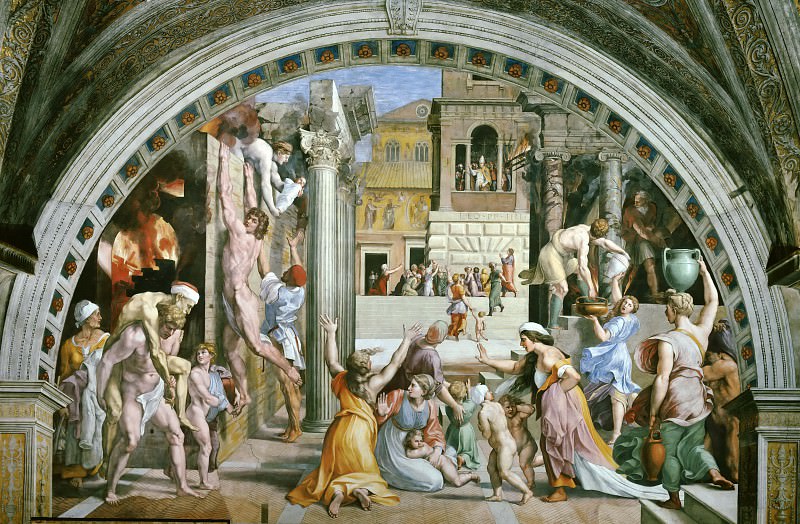Stanza Fire in the Borgo: Fire in the Borgo Raphael (1483-1520)
Raphael – Stanza Fire in the Borgo: Fire in the Borgo
Edit attribution
Download full size: 4200×2747 px (3,2 Mb)
Painter: Raphael
Location: Vatican Museums (fresco) (Musei Vaticani (murales)), Vatican.
The fresco Fire in Borgo tells the story of events taking place in a central area of Rome. Legend has it that a fire broke out near the palace of the Pope, which only subsided after Pope Leo IV himself appeared. Appearing on the balcony, the pope stopped the fire with the sign of the cross, aimed at the crowd and the flames that framed an entire block of Rome. The painting depicts the panic and terror of the inhabitants of Rome suffering under the indomitable tongues of flame.
Description of Raphael Santi’s painting Fire at Borgo
The fresco Fire in Borgo tells the story of events taking place in a central area of Rome. Legend has it that a fire broke out near the palace of the Pope, which only subsided after Pope Leo IV himself appeared. Appearing on the balcony, the pope stopped the fire with the sign of the cross, aimed at the crowd and the flames that framed an entire block of Rome.
The painting depicts the panic and terror of the inhabitants of Rome suffering under the indomitable tongues of flame. In the upper left corner we see a woman handing over her infant child from a balcony to a man in order to save the child from the elements. Embraced by the flames, she is ready to sacrifice herself to save her child.
Below is a part of the area, engulfed in bright red tongues of flame and black smoke. The overall light color palette of the work is emphasized by the darkest part of the composition which conveys the bearing of death and indomitability of the elements, and the distress that has suddenly overtaken the peaceful town. To the right is an expressive group of people with jugs of water, making every effort to save themselves. In the central and farthest part of the painting one can see a building, on the balcony of which stands Pope Leo IV, directing the sign of the cross toward the immense flames. In anticipation of the Holy One’s miracle and salvation, a group of women and children gather under the balcony, stretching out their arms toward their ruler. They are praising the pope and begging him to save Rome from the fire.
The painting shows a handsome young man, Aeneas, carrying an exhausted old man on his shoulders from the burning quarter. Next to him is his wife Creusa and his son Ascanius. The appearance of Aeneas on the canvas indicates that the main subject of the cloth originates from Virgil’s Troy, which also describes the fire.
Кому понравилось
Пожалуйста, подождите
На эту операцию может потребоваться несколько секунд.
Информация появится в новом окне,
если открытие новых окон не запрещено в настройках вашего браузера.
You need to login
Для работы с коллекциями – пожалуйста, войдите в аккаунт (open in new window).




















You cannot comment Why?